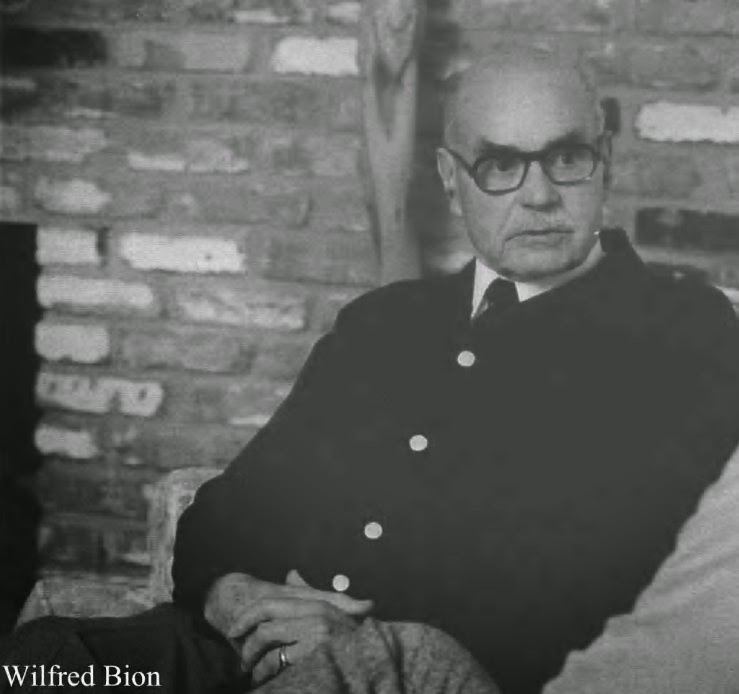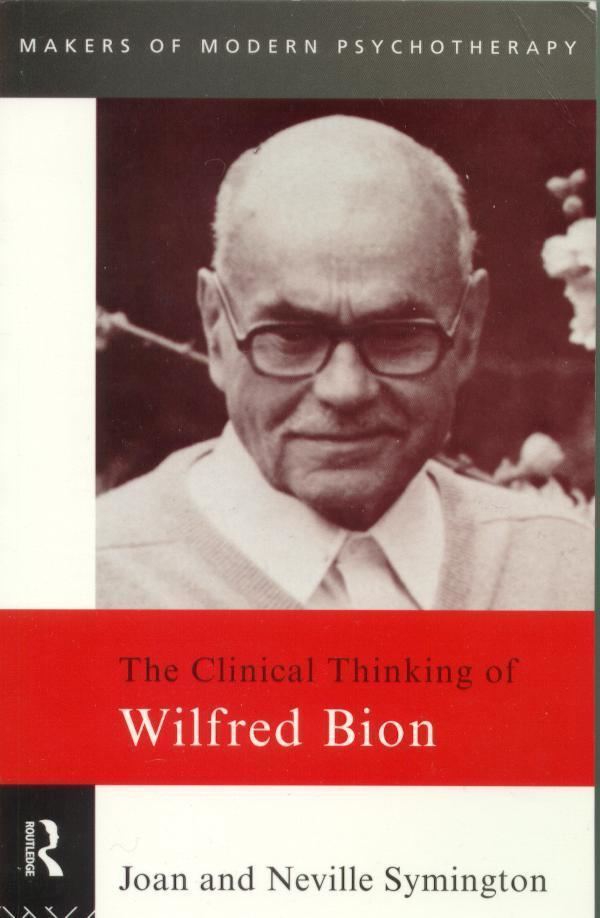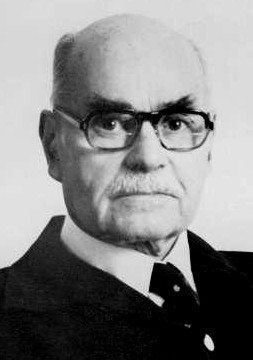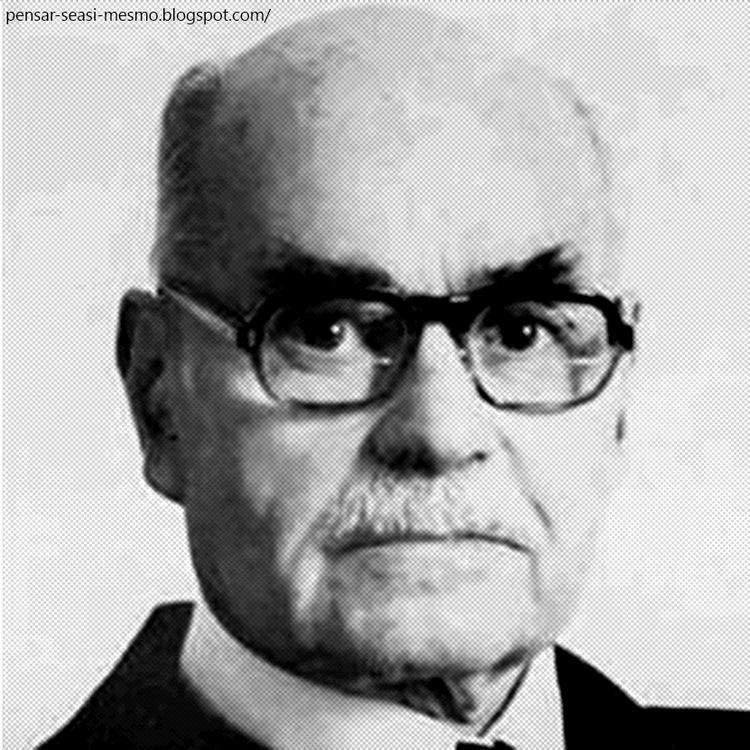Role Psychoanalyst | Name Wilfred Bion Children Parthenope Bion Talamo | |
 | ||
Full Name Wilfred Ruprecht Bion Known for Group psychotherapySocio-analysisObject relations theoryContainment theory Spouse(s) Betty JardineFrancesca Bion Books Experiences in groups and other, Learning from Experience, Attention and interpretation, Cogitations : new extended, A Memoir of the Future Similar People Melanie Klein, Donald Winnicott, Hanna Segal, Jacques Lacan, Michael Balint | ||
Wilfred bion en la tavistock clinic
Wilfred Ruprecht Bion DSO (; 8 September 1897 – 8 November 1979) was an influential British psychoanalyst, who became president of the British Psychoanalytical Society from 1962 to 1965.
Contents
- Wilfred bion en la tavistock clinic
- Wilfred bion
- Military service
- Career
- Group dynamicsthe basic assumptions
- Bion on thinking
- Alpha elements beta elements and alpha function
- Knowledge love and hate
- Reversible perspective and K
- O The ineffable
- Reverie
- Late Bion
- References

Wilfred Bion was a potent and original contributor to psychoanalysis. He was one of the first to analyze patients in psychotic states using an unmodified analytic technique; he extended existing theories of projective processes and developed new conceptual tools. The degree of collaboration between Hanna Segal, Wilfred Bion and Herbert Rosenfeld in their work with psychotic patients during the late 1950s, and their discussions with Melanie Klein at the time, means that it is not always possible to distinguish their exact individual contributions to the developing theory of splitting, projective identification, unconscious phantasy and the use of countertransference. As Donald Meltzer (1979, 1981), Denis Carpy (1989, p. 287), and Michael Feldman (2009, pp. 33, 42) have pointed out, these three pioneering analysts not only sustained Klein’s clinical and theoretical approach, but through an extension of the concept of projective identification and countertransference they deepened and expanded it. In Bion’s clinical work and supervision the goal remains insightful understanding of psychic reality through a disciplined experiencing of the transference–countertransference, in a way that promotes the growth of the whole personality.

'Bion's ideas are highly unique', so that he 'remained larger than life to almost all who encountered him'. He has been considered by Neville Symington as possibly "the greatest psychoanalytic thinker...after Freud".

Wilfred bion
Military service

Bion was born in Mathura, North-Western Provinces, India, and educated at Bishop's Stortford College in England. After the outbreak of the First World War, he served in the Tank Corps as a tank commander in France, and was awarded both the Distinguished Service Order (DSO) (on 18 February 1918, for his actions at the Battle of Cambrai), and the Croix de Chevalier of the Légion d'honneur. He first entered the war zone on 26 June 1917, and was promoted to temporary lieutenant on 10 June 1918, and to acting captain on 22 March 1918, when he took command of a tank section, he retained the rank when he became second-in-command of a tank company on 19 October 1918, and relinquished it on 7 January 1919. He was demobilised on 1 September 1921, and was granted the rank of captain. The full citation for his DSO reads:

Awarded the Distinguished Service Order.

[...]

T./2nd Lt, Wilfred Ruprecht Bion, Tank Corps.
For conspicuous gallantry, and devotion to duty. When in command of his tank in an attack he engaged a large number of enemy machine guns in strong positions, thus assisting the infantry to advance. When his tank was put out of action by a direct hit he occupied a section of trench with his men and machine guns and opened fire on the enemy. He moved about in the open, giving directions to other tanks when they arrived, and at one period fired a Lewis gun with great effect from the top of his tank. He also got a captured machine gun into action against the enemy, and when reinforcements arrived he took command of a company of infantry whose commander was killed. He showed magnificent courage and initiative in a most difficult situation.
"Bion's daughter, Parthenope...raises the question of just how (and how far) her father was shaped as an analyst by his wartime experiences...under[p]inning Bion's later concern with the coexistence of regressed or primitive proto-mental states alongside more sophisticated one".
Career
After World War I, Bion studied history at The Queen's College, Oxford, earning a bachelor of arts degree in 1922, then studying medicine at University College London. Initially attracted to London by the "strange new subject called psychoanalysis", he met and was impressed by Wilfred Trotter, an outstanding brain surgeon who published the famous Instincts of the Herd in Peace and War in 1916, based on the horrors of the First World War. This was to prove an important influence on Bion's interest in group behavior. Having qualified in medicine by means of the Conjoint Diploma (MRCS England, LRCP London) in 1930 Bion spent seven years in psychotherapeutic training at the Tavistock Clinic, an experience he regarded, in retrospect, as having had some limitations. It did, however, bring him into fruitful contact with Samuel Beckett. He wanted to train in Psychoanalysis and in 1938 he began a training analysis with John Rickman, but this was brought to an end by the Second World War.
He was recommissioned in the Royal Army Medical Corps as a lieutenant on 1 April 1940, and worked in a number of military hospitals including Northfield Military Hospital (Hollymoor Hospital, Birmingham) where he initiated the first Northfield Experiment. These ideas on the psychoanalysis of groups were then taken up and developed by others such as S. H. Foulkes, Rickman, Bridger, Main and Patrick De Mare. The entire group at Tavistock had in fact been taken into the army, and were working on new methods of treatment for psychiatric casualties (those suffering post-traumatic stress, or "shell shock" as it was then known.) Out of this his pioneering work in group dynamics, associated with the "Tavistock group", Bion's papers describing his work of the 1940's were compiled much later and appeared together in 1961 in his influential book, Experiences in Groups and other papers. It was less a guide for the therapy of individuals within or by the group, than an exploration of the processes set off by the complex experience of being in a group. The book quickly became a touchstone work for applications of group theory in a wide variety of fields.
During the war Bion's wife, Betty Jardine, gave birth to a daughter, but, tragically, she died soon afterwards in 1945. His daughter, Parthenope, became a highly regarded psychoanalyst In Italy. She died prematurely, in a car crash in Italy in 1998.
Returning to the Tavistock Clinic Bion chaired the Planning Committee that reorganized the Tavistock into the new Tavistock Institute of Human Relations, alongside a new Tavistock Clinic which was part of the newly launched National Health Service. As his interest in psychoanalysis increased, he underwent training analysis, between 1946 and 1952, with Melanie Klein. He met his second wife, Francesca, at the Tavistock in 1951. He joined a research group of Klein's students (including Hanna Segal and Herbert Rosenfeld), who were developing Klein's theory of the paranoid-schizoid and the depressive positions, for use in the analysis of patients with psychotic disorders. He produced a series of highly original and influential papers (collected as "Second Thoughts", 1967) on the analysis of schizophrenia, and the specifically cognitive, perceptual, and identity problems of such patients. To this he added a valuable final section called Commentary, showing how some of his views on clinical and theoretical matters had changed.
Bion's theories, which were always based in the phenomena of the analytic encounter, revealed both correspondences and expansions of core ideas from both Sigmund Freud and Melanie Klein. At one point, he attempted to understand thoughts and thinking from an 'algebraic', 'geometric' and 'mathematised' point of view, believing there to be too little precision in the existing vocabulary, a process culminating in "The Grid". Later he abandoned the complex, abstract applications of mathematics, and the Grid, and developed a more intuitive approach, epitomised in Attention and Interpretation (1970).
He spent his later years in Los Angeles, California, before returning to the UK shortly before his death at Oxford.
He left a reputation which has grown steadily both in Britain and internationally. Some commentators consider that his writings are often gnomic and irritating, but never fail to stimulate. He defies categorisation as a follower of Klein or of Freud. While Bion is most well known outside of the psychoanalytic community for his work on group dynamics, the psychoanalytic conversation that explores his work is mainly concerned with his theory of thinking, and his model of the development of a capacity for thought.
Group dynamics—the "basic assumptions"
Wilfred Bion's observations about the role of group processes in group dynamics are set out in Experiences in Groups and other papers, written in the 1940's but compiled and published in 1961, where he refers to recurrent emotional states of groups as 'basic assumptions'. Bion argues that in every group, two groups are actually present: the work group, and the basic assumption group. The work group is that aspect of group functioning which has to do with the primary task of the group—what the group has formed to accomplish; will 'keep the group anchored to a sophisticated and rational level of behaviour'. The basic assumption group describes the tacit underlying assumptions on which the behaviour of the group is based. Bion specifically identified three basic assumptions: dependency, fight-flight, and pairing. When a group adopts any one of these basic assumptions, it interferes with the task the group is attempting to accomplish. Bion believed that interpretation by the therapist of this aspect of group dynamics would, whilst being resisted, also result in potential insight regarding effective, co-operative group work.
In dependency, the essential aim of the group is to attain security through, and have its members protected by, one individual. The basic assumption in this group culture seems to be that an external object exists whose function it is to provide security for the immature individual. The group members behave passively, and act as though the leader, by contrast, is omnipotent and omniscient. For example, the leader may pose a question only to be greeted with docile silence, as though he or she had not spoken at all. The leader may be idealized into a kind of god who can take care of his or her children, and some especially ambitious leaders may be susceptible to this role. Resentment at being dependent may eventually lead the group members to "take down" the leader, and then search for a new leader to repeat the process.
In the basic assumption of fight-flight, the group behaves as though it has met to preserve itself at all costs, and that this can only be done by running away from someone or fighting someone or something. In fight, the group may be characterized by aggressiveness and hostility; in flight, the group may chit-chat, tell stories, arrive late or any other activities that serve to avoid addressing the task at hand. The leader for this sort of group is one who can mobilize the group for attack, or lead it in flight.
The final basic assumption group, pairing, exists on the assumption that the group has met for the purpose of reproduction—the basic assumption that two people can be met together for only one purpose, and that a sexual one'. Two people, regardless the sex of either, carry out the work of the group through their continued interaction. The remaining group members listen eagerly and attentively with a sense of relief and hopeful anticipation.
Bion considered that "the three basic-assumption groups seem each in turn to be aggregates of individuals sharing out between them the characteristics of one character in the Oedipal situation". Behind the Oedipal level, however, Bion postulated the existence of still more primitive, part-object phantasies; and 'the more disturbed the group, the more easily discernible are these primitive phantasies and mechanisms'. Such phantasies would prove the main focus of Bion's interest after his second analysis.
Bion on thinking
"During the 1950s and 1960s, Bion transformed Melanie Klein's theories of infantile phantasy...into an epistemological "theory of thinking" of his own." Bion used as his starting point the phenomenology of the analytic hour, highlighting the two principles of "the emergence of truth and mental growth. The mind grows through exposure to truth." The foundation for both mental development and truth are, for Bion, emotional experience.
The evolution of emotional experience into the capacity for thought, and the potential derailment of this process, are the primary phenomena described in Bion's model. Through his hypothesized alpha and beta elements, Bion provides a language to help one think about what is occurring during the analytic hour. These tools are intended for use outside the hour in the clinician’s reflective process. To attempt to apply his models during the analytic session violates the basic principle whereby "Bion had advocated starting every session 'without memory, desire or understanding'—his antidote to those intrusive influences that otherwise threaten to distort the analytic process."
Alpha elements, beta elements, and alpha function
Bion created a theory of thinking based on changing beta elements (unmetabolized psyche/soma/affective experience) into alpha elements (thoughts that can be thought by the thinker). Beta elements were seen as cognate to the underpinnings of the "basic assumptions" identified in his work with groups: "the fundamental anxieties that underlie the basic assumption group resistances were originally thought of as proto-mental phenomena...forerunners of Bion's later concept of beta-elements." They were equally conceptual developments from his work on projective identification—from the "minutely split 'particles'" Bion saw as expelled in pathological p.i. by the psychotic, who would then go on to "lodge them in the angry, so-called 'bizarre objects' by which he feels persecuted and controlled". For "these raw bits of experience he called beta-elements...to be actively handled and made use of by the mind they must, through what Bion calls alpha-functions, become alpha-elements".
β elements, α elements and α function are elements that Bion (1963) hypothesizes. He does not consider β-elements, α- elements, nor α function to actually exist. The terms are instead tools for thinking about what is being observed. They are elements whose qualities remain unsaturated, meaning we cannot know the full extent or scope of their meaning, so they are intended as tools for thought rather than real things to be accepted at face value (1962, p. 3).
Bion took for granted that the infant requires a mind to help it tolerate and organize experience. For Bion, thoughts exist prior to the development of an apparatus for thinking. The apparatus for thinking, the capacity to have thoughts "has to be called into existence to cope with thoughts" (1967, p. 111). Thoughts exist prior to their realization. Thinking, the capacity to think the thoughts which already exist, develops through another mind providing α-function (1962, p. 83)—through the "container" role of maternal reverie.
To learn from experience alpha-function must operate on the awareness of the emotional experience; alpha–elements are produced from the impressions of the experience; these are thus made storable and available for dream thoughts and for unconscious waking thinking... If there are only beta-elements, which cannot be made unconscious, there can be no repression, suppression, or learning. (Bion, 1962, p. 8)
α-function works upon undigested facts, impressions, and sensations, that cannot be mentalized—beta-elements. α-function digests β-elements, making them available for thought (1962, pp. 6–7).
Beta-elements are not amenable to use in dream thoughts but are suited for use in projective identification. They are influential in producing acting out. These are objects that can be evacuated or used for a kind of thinking that depends on manipulation of what are felt to be things in themselves as if to substitute such manipulations for words or ideas... Alpha-function transforms sense impressions into alpha-elements which resemble, and may in fact be identical with, the visual images with which we are familiar in dreams, namely, the elements that Freud regards as yielding their latent content when the analyst has interpreted them. Failure of alpha-function means the patient cannot dream and therefore cannot sleep. As alpha-function makes the sense impressions of the emotional experience available for conscious and dream—thought the patient who cannot dream cannot go to sleep and cannot wake up. (1962, pp. 6–7)
Knowledge, love and hate
Successful application of alpha-function leads to "the capacity to tolerate the actual frustration involved in learning ("K") that [Bion] calls 'learning from experience'". The opposite of knowledge "K" was what Bion termed "−K": "the process that strips, denudes, and devalues persons, experiences, and ideas."
Both K and −K interact for Bion with Love and Hate, as links within the analytic relationship. "The complexities of the emotional link, whether Love or Hate or Knowledge [L, H, and K — the Bionic relational triad]" produce ever-changing "atmospheric" effects in the analytic situation. The patient's focus may wish to be "on Love and Hate (L and H) rather than the knowledge (K) that is properly at stake in psychoanalytic inquiry."
For Bion, "knowledge is not a thing we have, but a link between ourselves and what we know ... K is being willing to know but not insisting on knowledge." By contrast, -K is "not just ignorance but the active avoidance of knowledge, or even the wish to destroy the capacity for it" — and "enacts what 'Attacks on Linking' identifies as hatred of emotion, hatred of reality, hatred of life itself."
Looking for the source of such hate (H), Bion notes in Learning from Experience that, "Inevitably one wonders at various points in the investigation why such a phenomenon as that represented by −K should exist. ... I shall consider one factor only — Envy. By this term I mean the phenomenon described by Melanie Klein in Envy and Gratitude" (1962, p. 96).
Reversible perspective and −K
"Reversible Perspective" was a term coined by Bion to illuminate "a peculiar and deadly form of analytic impasse which defends against psychic pain". It represents the clash of "two independently experienced views or phenomena whose meanings are incompatible". In Bion's own words, "Reversible perspective is evidence of pain; the patient reverses perspective so as to make a dynamic situation static."
As summarised by Etchegoyen, "Reversible perspective is an extreme case of rigidity of thought. ... As Bion says, what is most characteristic in such cases is the manifest accord and the latent discord." In clinical contexts, what may happen is that the analyst's "interpretation is accepted, but the premises have been rejected ... the actual specificity, the substance of the interpretation". Reversible perspective is an aspect of "the potential destruction and deformation of knowledge" — one of the attacks on linking of −K.
O: The ineffable
As his thought continued to develop, Bion came to use Negative Capability and the suspension of Memory and Desire in his work as an analyst, in order to investigate psychic reality - which he regarded as essentially 'non-sensuous' (1970). Following his 1965 book Transformations he had an increasing interest in what he termed the domain of "O" — the unknowable, or ultimate Truth. "In aesthetics, Bion has been described as a neo-Kantian for whom reality, or the thing-in-itself (O), cannot be known, only be "be-ed" (1965). What can be known is said by Bion to be in the realm of K, impinging through its sensory channels. If the observer can desist from "irritably reaching for fact and reason", and suspend the normal operation of the faculties of memory and apperception, what Bion called transformations in knowledge can permit an 'evolution' where transformations in K touch on transformations in Being (O). Bion believed such moments to feel both ominous and turbulent, threatening a loss of anchorage in everyday 'narrative' security.
Bion would speak of "an intense catastrophic emotional explosion O," which could only be known through its aftereffects. Where before he had priviledged the domain of knowledge (K), now he would speak as well of "resistance to the shift from transformations involving K (knowledge) to transformations involving O ... resistance to the unknowable". Hence his injunctions to the analyst to eschew memory and desire, to "bring to bear a diminution of the 'light' — a penetrating beam of darkness; a reciprocal of the searchlight. If any object existed, however faint, it would show up very clearly". In stating this he was making connections to Freud, who in a letter to Lou Andreas Salome had referred to a mental counterpart of scotopic, "mole like vision", used to gain impressions of the Unconscious. He was also making links with the apophatic method used by contemplative thinkers such as St John of the Cross, a writer quoted many times by Bion. Bion was well aware that our perception and our attention often blind us to what genuinely and strikingly is new in every moment.
Reverie
Bion's concept of maternal "reverie" as the capacity to sense (and make sense of) what is going on inside the infant has been an important element in post-Kleinian thought: "Reverie is an act of faith in unconscious process ... essential to alpha-function'" It is considered the equivalent of Stern's attunement, or Winnicott's maternal preoccupation.
In therapy, the analyst's use of "reverie" is an important tool in his/her response to the patient's material: "It is this capacity for playing with a patient's images that Bion encouraged".
Late Bion
"For the later Bion, the psychoanalytic encounter was itself a site of turbulence, 'a mental space for further ideas which may yet be developed'." In his unorthodox quest to maintain such "mental space", Bion "spent the final years of his long and distinguished professional life [writing] a futuristic trilogy in which he is answerable to no one but himself, A Memoir of the Future."
If we accept that "Bion introduced a new form of pedagogy in his writings...[via] the density and non-linearity of his prose", it comes perhaps to a peak here in what he himself termed "a fictitious account of psychoanalysis including an artificially constructed dream ... science fiction". We may conclude at least that he achieved his stated goal therein: "To prevent someone who KNOWS from filling the empty space".
